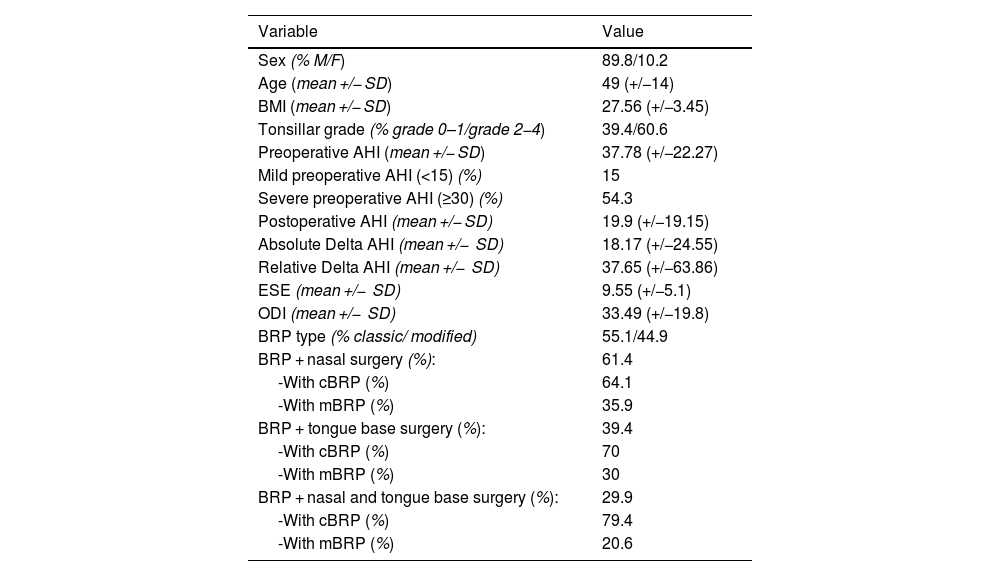The use of barbed sutures for pharyngoplasty techniques is a new trend in sleep apnea surgery, but little is known about its short-term results depending on the different techniques. The purpose of this study was to analyse the surgical results in two different centres using barbed sutures with different barbed pharyngoplasty techniques.
Material and methodsThis is a multicenter retrospective study of patients with obstructive sleep apnea (OSA) undergoing surgery, all of whom underwent pharyngoplasty with barbed suture using a classic or modified technique, which may or may not be associated with other surgical techniques. A univariate and multivariate statistical analysis were performed to assess the relationship of these surgical techniques with surgical success and with different descriptive variables.
ResultsThe final sample size was 126 patients. A surgical success rate of 39.7% was obtained for a postoperative AHI < 10/h and a 51.6% success rate according to Sher's criteria. A greater proportion of success was observed in the modified barbed pharyngoplasty technique that was not maintained after the multivariate analysis, as with other factors such as age, ODI or the presence of nasal surgery.
ConclusionNon-resective pharyngoplasty with barbed sutures is an effective technique for the treatment of OSA in selected patients, with both the classic technique and the modified alternatives having good postoperative results, with no differences observed in relation to surgical success between both. More studies are necessary to evaluate the differences between both techniques in more homogeneous groups.
El uso de suturas barbadas para técnicas de faringoplastia es una nueva tendencia en la cirugía de la apnea del sueño, pero se sabe poco sobre sus resultados a corto plazo dependiendo de las diferentes técnicas. El objetivo de este estudio fue analizar los resultados quirúrgicos utilizando suturas barbadas con diferente técnica de faringoplastia barbada.
Material y métodosSe trata de un estudio retrospectivo multicéntrico de pacientes con apnea obstructiva del sueño (AOS) operados, realizándose en todos ellos faringoplastia con sutura barbada mediante técnica clásica o modificada, pudiendo asociarse o no a otras técnicas quirúrgicas. Se realizó un análisis estadístico uni y multivariante para estudiar la relación de estas técnicas quirúrgicas con el éxito quirúrgico y con diferentes variables descriptivas.
ResultadosEl tamaño de la muestra final fue de 126 pacientes. Se obtuvo un porcentaje de éxito quirúrgico del 39,7% para un IAH postoperatorio <10/h y un 51,6% de éxito según criterios de Sher. Se observó una mayor proporción de éxito en la técnica de faringoplastia barbada modificada que no se mantuvo tras el análisis multivariante, al igual que con otros factores como la edad, el IDO o la presencia de cirugía nasal.
ConclusiónLa faringoplastia no resectiva con suturas barbadas es una técnica eficaz para el tratamiento del AOS en pacientes seleccionados, siendo tanto la técnica clásica como la modificada alternativas con buenos resultados postoperatorios, sin haber observado diferencias en relación al éxito quirúrgico entre ambas. Son necesarios más estudios que evalúen las diferencias entre ambas técnicas en grupos más homogéneos.










